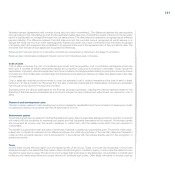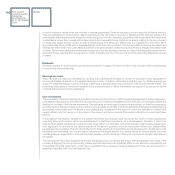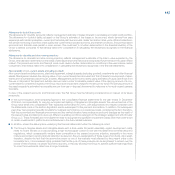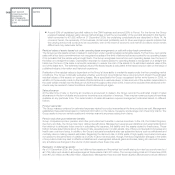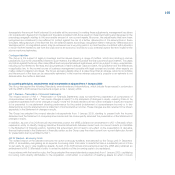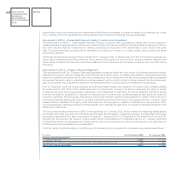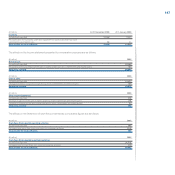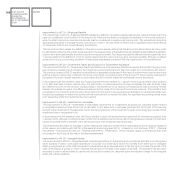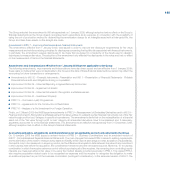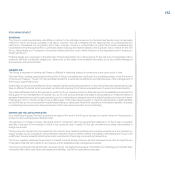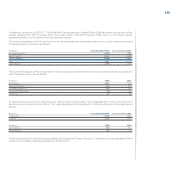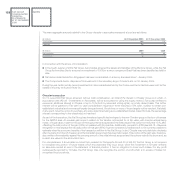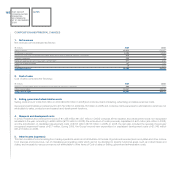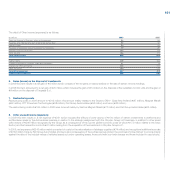Chrysler 2009 Annual Report Download - page 152
Download and view the complete annual report
Please find page 152 of the 2009 Chrysler annual report below. You can navigate through the pages in the report by either clicking on the pages listed below, or by using the keyword search tool below to find specific information within the annual report.
151
issuing equity instruments to be classified as current. That led to liabilities relating to convertible bonds which could be
converted at any time into the shares of the issuer to be classified as current. Following this amendment the existence of a
currently exercisable option for conversion into equity instruments becomes irrelevant for the purposes of the current/non-
current classification of a liability.
IAS 7 – Statement of Cash Flows: this amendment, applicable from 1 January 2010, clarifies that only expenditures that result
in a recognised asset in the statement of financial position are eligible for classification as investing activities in the statement
of cash flows; cash flows originating from expenditures that do not result in a recognised asset (as could be the case for
advertising and promotional activities and staff training) must be classified as cash flows from operating activities.
IAS 17 – Leases: following the changes, the general conditions required by IAS 17 for classifying a lease as a finance lease
or an operating lease will also be applicable to the leasing of land, independent of whether the lease transfers ownership
by the end of the lease term. Before these changes the standard required the lease to be classified as an operating lease
if ownership of the leased land was not transferred at the end of the lease term because land has an indefinite useful life.
The amendment is effective from 1 January 2010. At the date of adoption the classification of all land elements of unexpired
leases must be reassessed, with any lease newly classified as a finance lease to be recognised retrospectively.
IAS 36 – Impairment of Assets: this amendment, effective prospectively from 1 January 2010, states that each unit or group
of units to which goodwill is allocated for the purpose of impairment testing shall not be larger than an operating segment
as defined by paragraph 5 of IFRS 8 before any aggregation on the basis of similar economic characteristics and other
similarities as permitted by paragraph 12 of IFRS 8.
IAS 38 – Intangible Assets: IFRS 3 (as revised in 2008) states that if an intangible asset acquired in a business combination
is separable or arises from contractual or other legal rights, sufficient information exists to measure its fair value reliably;
amendments are made to IAS 38 to reflect that revision of IFRS 3. Moreover these amendments clarify the valuation
techniques commonly used to measure intangible assets at fair value when assets are not traded in an active market; in
particular, such techniques include discounting the estimated future net cash flows from an asset, and estimating the costs
the entity avoids by owning an intangible asset and not having to license it from another party in an arm’s length transaction
or the costs to recreate or replace it (as in the cost approach). The amendment is effective prospectively from 1 January
2010.
IAS 39 – Financial Instruments: Recognition and Measurement: this amendment restricts the non-applicability of IAS 39
under paragraph 2(g) of the standard to forward contracts between an acquirer and a selling shareholder to buy or sell an
acquiree in a business combination at a future acquisition date when the completion of the business combination is not
dependant on further actions of either party and only the passage of a normal period of time is required. Option contracts,
whether or not currently exercisable, which allow one party to control the occurrence or non-occurrence of future events
and on exercise will result in control of an entity are therefore included in the scope of IAS 39. The amendment also clarifies
that embedded prepayment options whose exercise price compensates the lender for the loss of interest income resulting
from the prepayment of the loan shall be considered closely related to the host debt contract and therefore not accounted
for separately. Finally, the amendment clarifies that the gains or losses on a hedged instrument must be reclassified from
equity to profit or loss during the period that the hedged forecast cash flows affect profit or loss. The amendment is effective
prospectively from 1 January 2010.
IFRIC 9 – Reassessment of Embedded Derivatives: this amendment excludes from the scope of IFRIC 9 embedded
derivatives in contracts acquired in a business combination, a combination of entities or businesses under common control
or the formation of a joint venture. The amendment is applicable prospectively from 1 January 2010.
In June 2009, the IASB issued an amendment to IFRS 2 – Share based payment: Group Cash-settled Share-based Payment
transactions. The amendment clarifies the scope of IFRS 2 and the interactions of IFRS 2 and other standards. In particular, it
clarifies that an entity that receives goods or services in a share-based payment arrangement must account for those goods or
services no matter which entity in the group settles the transaction, and no matter whether the transaction is settled in shares or
cash; moreover, it clarifies that a ‘group’ has the same meaning as in IAS 27 - Consolidated and Separate Financial Statements,
that is, it includes only a parent and its subsidiaries. In addition, the amendment clarifies that an entity must measure the goods


